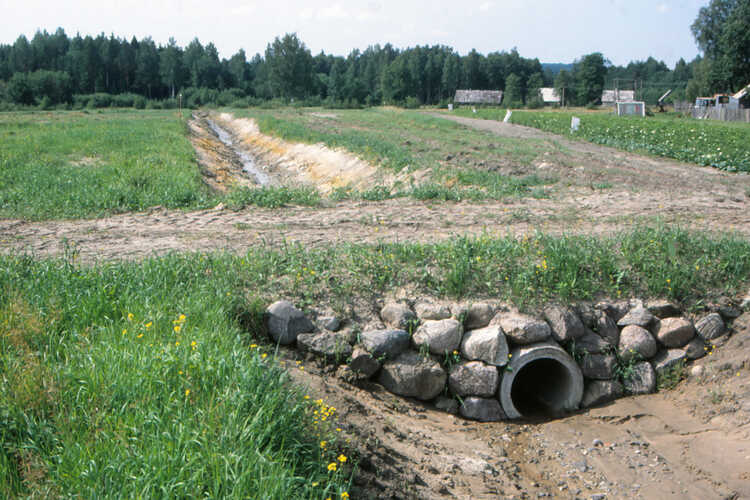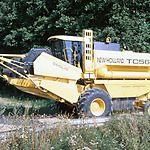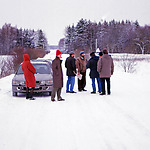Because preparations were going rather complicated, I was asked if I could see if this could be improved. In March 1995, I made my first visit together with a UNESCO-IHE colleague. The core question was to advise on getting the field drainage and discharge systems restored and running again. This did not only concern the technology, but also the organization, the role of the farmers and the authorities, the costs and the benefits.
I had been involved in several such missions at that time, where the trick was always to find out in a short time what exactly was going on. In this case I quickly got the impression that the Estonians knew exactly what they wanted, but that this differed considerably from what the World Bank consultants advised. First of all, it was about the land that had been exploited as agricultural cooperatives (kolkhoz and sovkhoz) during the Soviet Union period having to be returned in some way to the grandchildren of the original owners. Estonia had a clear approach for this with various possibilities. At the time of this visit, 11% of the land had already been returned in this way - four years after independence - which the consultants considered too slow and I considered it a huge achievement. Moreover, in Estonia, as far as water management was concerned, they only wanted to get things going again and only make improvements in a second round, when everything was working well.
In close consultation with my Estonian counterparts, I actually only wrote down what they wanted and made a budget for them. This plan was somewhat at odds with the much more advanced ideas that the World Bank consultants had regarding the best approach. However, our plan was accepted by the World Bank and the project eventually started in the autumn of 1996.
The Estonians then asked if I could come by for a week twice a year, during the two years of the project, to discuss the main points and to advise on possible adjustments. I felt honoured and said yes. I did this partly because I found the developments interesting and the Estonians had made a very positive impression on me. Eventually, a second phase and another project were added and I visited twice a year for four years.
I always worked with the head and two employees of the Amelioration Unit, and with the regional representatives in the different areas. You could say the group within the Ministry of Agriculture, which was responsible for rural development. We were always accompanied by an excellent interpreter, who was also well informed about the content, which worked very well. During each mission, I also visited the head of the Land Registry, who kept track of land ownership for the whole of Estonia – about 1.5 million inhabitants. I discussed with him each time the progress of the restitution of land ownership.
I usually arrived on Sunday and started on Monday by requesting all kinds of information, going through the status of the project, discussing my program and making the necessary courtesy calls at the Ministry of Agriculture and the regional World Bank office. The project started with the renovation of 15 areas – each about a thousand hectares – for which we had had many intensive discussions to get them started. During my second visit they all appeared to be in progress, and designs were being made for 20 new areas. I wanted to include a preliminary overview in my report. I was promised that I would have all the information by Friday. And certainly in Estonia a deal is a deal, so I did not have to worry about whether I would actually get it.
The next day we went on a field visit to see various projects in progress and in preparation. We, together with some of the local staff, the chairman of the Land and Water Association (LWA), the designer and the contractor, visited a project in progress. It looked reasonable, but not impressive. We also visited an area that was currently being designed and then went to one of the first areas where the field drainage and discharge system had been restored in 1996. We visited the area, again together with local staff, the chairman of the LWA, the designer and the contractor. Everything was in good condition and the information was that everything had worked very well and everyone was happy.
All visits followed a similar programme. During my last visit, the terminal building of Tallinn airport was being completely renovated, so we had to go through customs in an aluminium shed. For me, another clear signal of how energetically this country is tackling its affairs. On Monday morning, I took a taxi to the Ministry of Agriculture in the old city centre. I knew that my Estonian counterpart had meetings until 11 o'clock, but I also knew that I could then copy the necessary Excel files from his assistant and secretary, so that I already had them in my report. On Monday morning at 11 o'clock, I had therefore already copied the majority of the necessary data into my report. On which other mission was this possible?
My Estonian counterpart indeed entered the room at about 11 o’clock and something new happened. He asked if we are going to have a cup of coffee in the canteen. During all previous missions I had never got anything to drink in the office. They didn’t take any themselves either. So the country was making progress. We had a coffee in the canteen and discussed the program for this mission. The project is going well, but in Estonia things are going bad. It has been raining all summer, exports to Russia have collapsed and the European Union is dumping cheap agricultural products. How are you supposed to survive as an Estonian farmer? Yet there seem to be many who manage to survive, although there are also a fair number of bankruptcies. This country is becoming Western. I am given a table showing how much maintenance had been carried out in the renovated areas. I cautiously asked whether this maintenance had indeed been carried out by the farmers themselves, because in most ‘developing countries’ this often leaves much to be desired. I am told to my satisfaction that this is indeed the case, but that it took a lot of effort to get the farmers to do so.
The man from the Ministry of the Environment comes to speak to me. They have to screen the project proposals for their environmental aspects. They are also doing a study into other possible uses for agricultural land. They have had quite a bit of trouble getting everything going, but now they have five consultants working to do all the work. He shows me a number of screening reports. They have completely caught up on their backlog in the past six months and have now screened all projects and project proposals. This has led to the cancellation of six projects and adjustments in about ten other projects. So the system works. The study into other possible uses for agricultural land will continue for another year, but there is now an interim report of which they will send me the summary.
Together with my Estonian counterpart I visit the office of the World Bank. The World Bank wants to follow up the loan with a second phase, because the project is going very well according to their standards. I go to the old town to eat something. Many buildings in the old town have been restored in the past months. If they continue at this pace, they will have renovated the entire old town in about five years and it will be one of the most beautiful old city centres in Europe. I walk through it with pleasure again, eat in one of the good restaurants and walk back to my hotel.
The restoration fever has hit Estonia hard. Even during our two-day field visit, the renovations were in full swing. For example, all the Amelioration offices we visited had been renovated somewhere and we could find a meeting room in the Tartu city hall that had just been renovated. The rest of the building was full of ladders, cement bags, paint cans, etc., and there was a lot of hammering and painting going on. In the building where the World Bank had its office, the elevators and corridors were being renovated. Even the street in front of the Ministry of Agriculture was suddenly dug up because something apparently had to be replaced. All the towers on the wall around the old city were fitted with new roof tiles and many streets in the old city were open because of all kinds of replacements. Many houses were in scaffolding to have their facades re-plastered. Furthermore, there were loud complaints that things were going so badly. I was not very impressed by this, because I had rarely seen so much activity.
The last field trip for the time being was a wonderful experience. This time we had mainly visited areas where the field drains, collector drains and canals had been renovated in 1997. This was the first year that the farmers themselves had to do the maintenance. The result was truly astonishing. Even in the furthest corners everything had been neatly mown and cleaned. Ready for the winter. At each area, and we visited about six, the chairman of the LWA was waiting for us somewhere along the road, armed with the necessary maps, and we were neatly driven to the places we indicated. There was really nothing wrong, and that in a country where the collapse of the Russian market had caused the sales prices for agricultural products to be halved. Sometimes incomprehensible to me, but they had done it.


